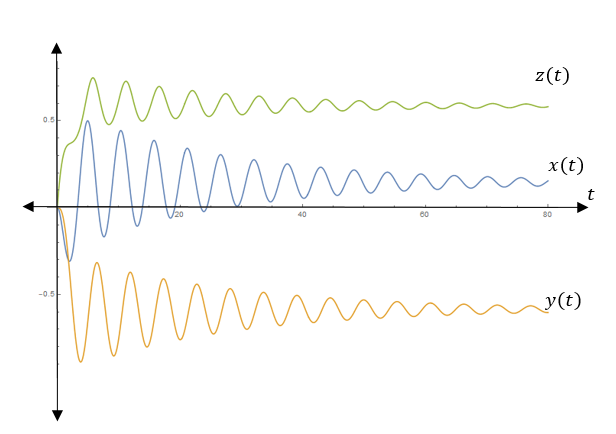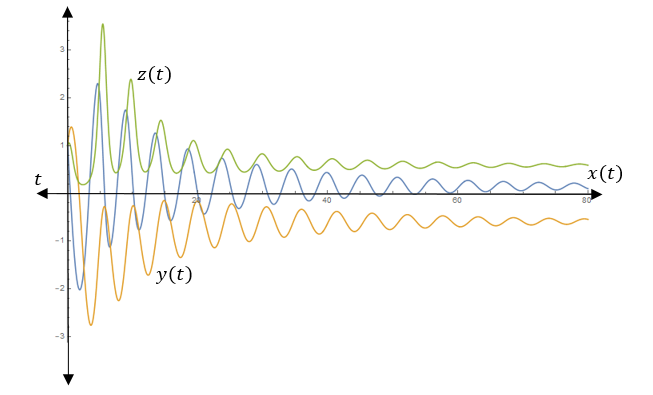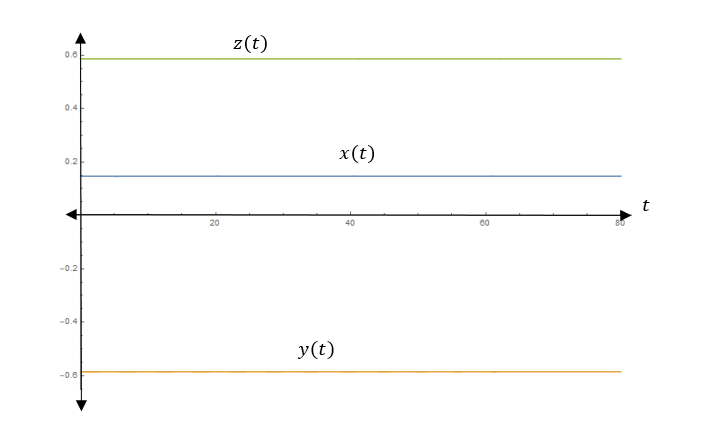
a) Show that there are no critical points when
b) Find the critical point(s) and determine the eigenvalues of the associated Jacobian matrix when
c) How do you think trajectories of the system will behavefor
d) Choose one or two other initial points and plot the corresponding trajectories. Do these plots agree with your expectations?
(a)
To prove: There are no critical points for the system
Explanation of Solution
Given information:
The system of equations is
Formula used:
Quadratic formula:
The roots of the equations
Proof:
Consider
By plugging
The system becomes
The points, if any, where
The critical points of the system
Consider the first equation
Consider the second equation
Now plug these value in the equation
By using the quadratic formula,
Thus the value of
That is,
Thus there is no critical point when
Also, there are two distinct real values of when
That is,
Thus there are two critical points when
If
Thus there is only one critical point for the system.
(b)
The critical points of the system
Answer to Problem 1P
Solution:
When
When
Explanation of Solution
Given information:
The system is
Explanation:
The system is
By plugging
The system becomes,
From part (a),
The critical point is
Hence if
Therefore, the critical point is
Since
i) Near the critical point
To find eigenvalues of the matrix
Let
The characteristics equation is
Thus the eigenvalues when
The system is
By plugging
The system becomes,
From part (a),
The critical point is
Hence if
That is,
Therefore, the critical points are
Since
ii) Near the critical point
To find eigenvalues of the matrix
Let
The characteristics equation is
iii) Near the critical point
To find eigenvalues of the matrix
Let
The characteristics equation is
Thus the eigenvalues when
(c)
How the trajectories of the system will behave for
Answer to Problem 1P
Solution:
As
The trajectory starting at origin is:

The graph is agreeing with our expectations.
Explanation of Solution
Given information:
The system is
Explanation:
The system is
From part (b),
The eigenvalues corresponding to the critical point
Thus one of the eigenvalueshasa positive real part. Therefore, the critical point
The eigenvalues corresponding to the critical point
Thus the eigenvalues have a negative real part. Therefore, the critical point
Therefore, as
The trajectory starting at the origin is:

As
Therefore, the graph is agreeing with our expectations.
(d)
To graph: The corresponding trajectories by choosing one or two initial points. Whether these plots agree with your expectations or not.
Explanation of Solution
Given information:
The system is
Graph:
The trajectory with the initial condition

The trajectory with the initial condition

The trajectory with the initial point close to

The trajectory with the initial point close to

Interpretation:
From the above graph,
All trajectories converge to the point
From part (c),
As
Therefore, the graph agrees with our expectations.
Want to see more full solutions like this?
Chapter 7 Solutions
Differential Equations: An Introduction to Modern Methods and Applications
Additional Math Textbook Solutions
Mathematics All Around (6th Edition)
The Heart of Mathematics: An Invitation to Effective Thinking
A Survey of Mathematics with Applications (10th Edition) - Standalone book
Mathematical Methods in the Physical Sciences
Finite Mathematics & Its Applications (12th Edition)
Mathematical Ideas (13th Edition) - Standalone book
 Linear Algebra: A Modern IntroductionAlgebraISBN:9781285463247Author:David PoolePublisher:Cengage Learning
Linear Algebra: A Modern IntroductionAlgebraISBN:9781285463247Author:David PoolePublisher:Cengage Learning
